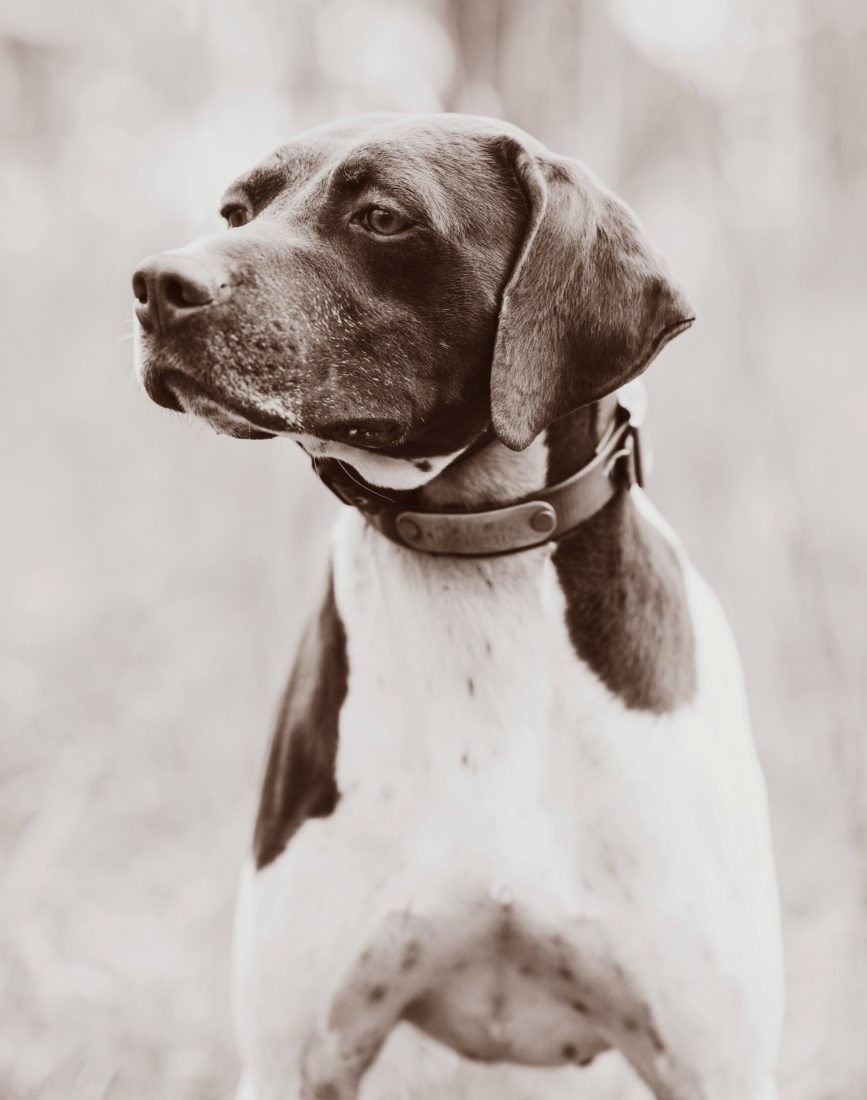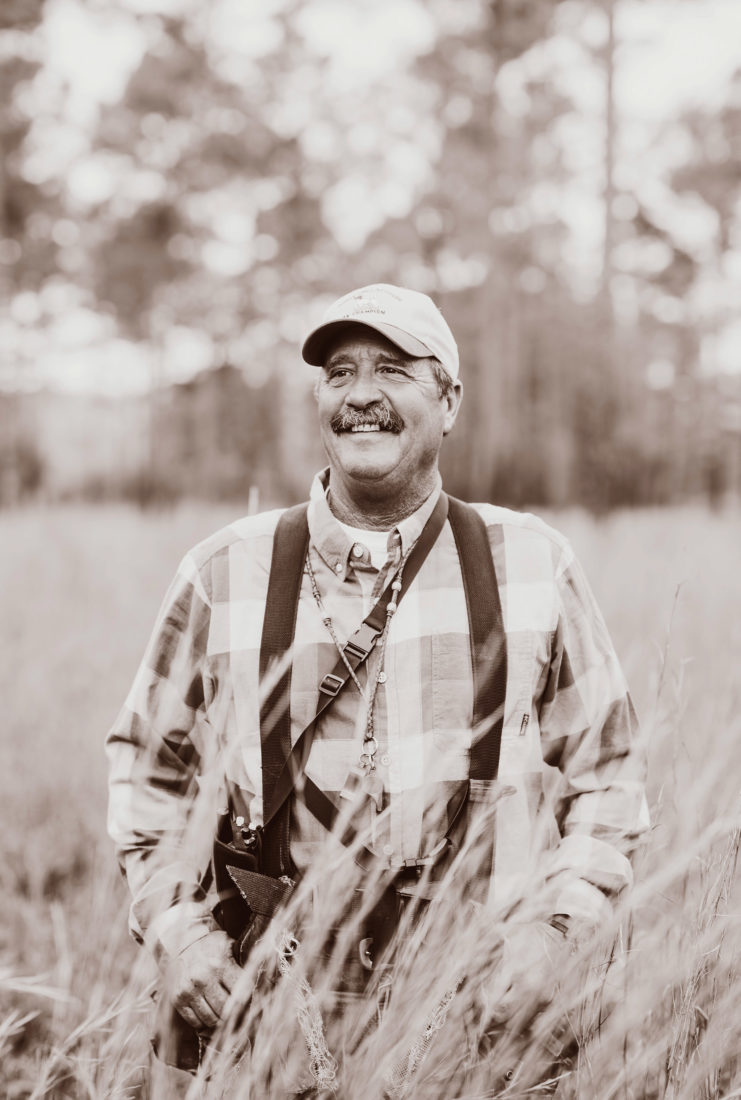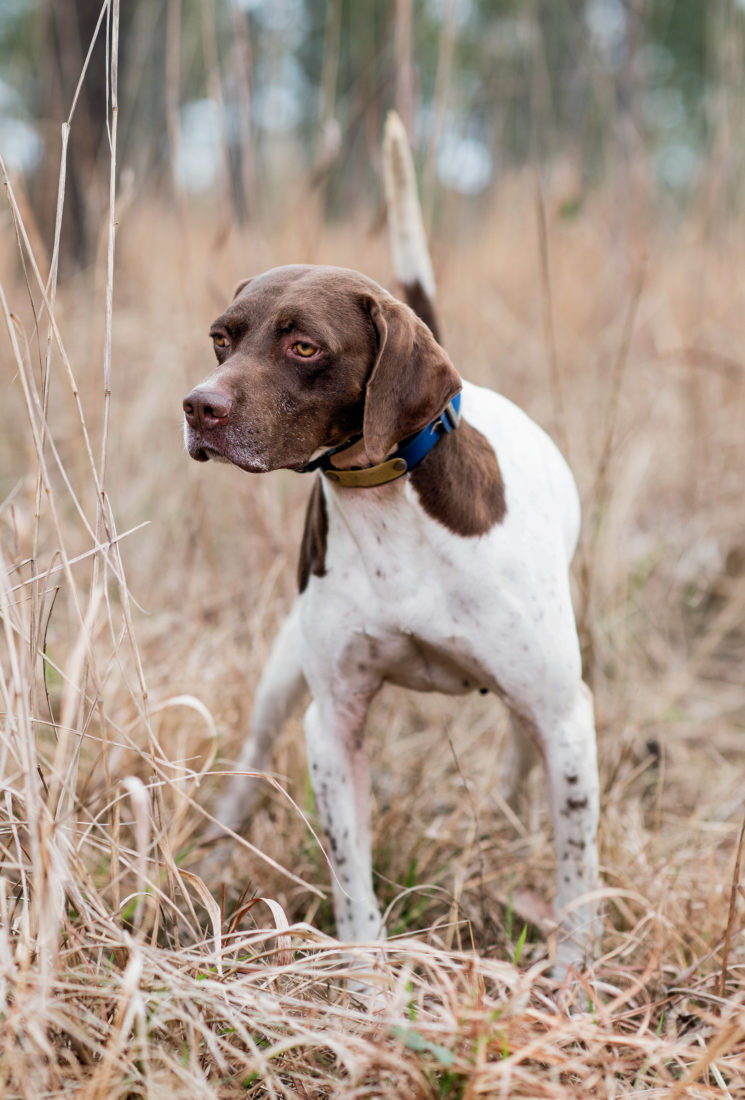Sporting
Secrets of the Bird-Dog Wizard
With an uncanny knack for working with bird dogs, Scott Miller became a legend on the field trial circuit. These days, he leads a quieter life in the Lowcountry, but he’s still training dogs, and, just as important, their owners

Photo: Andrew Hyslop
We’d given up on the point, despite Tieka’s staunch figure in the broomsedge, at a field corner near the cut sorghum, unwavering in her commitment. Scott Miller swept the brush twice with battered and dusty snake boots. We could have seen a june bug hiding in there. “Nothing,” he muttered, then walked two more steps in front of the dog before a tiny winter-brown sparrow leaped from its deep burrow in the bunchgrass.
“That must have been it,” Miller figured, nearly talking to himself. He tapped Tieka to release the dog, and the Brittany took a halting, you-sure-about-this half step when a single bobwhite quail launched from the brush, clawing for blue. My back was half turned, my shotgun dangling loose in my hand. My hunting partner, Fred Childs, Tieka’s owner, was caught flat-footed, as well. The dog did her job. We were beaten by the bird, fair and square.
“There’s our lesson for today,” Miller said, a grin pushing up the corners of a thick mustache. “Believe the dog. She’s the one with the nose.”
Believe the dog. That’s near the top of the list of any dog trainer’s mantras, but it comes with an unspoken subtext: Believe the dog that you’ve trained and worked to be believable. And when it comes to training bird dogs, there may be no one better in the South than Miller, an unassuming and universally heralded dog man who now runs the kennels at South Carolina’s Brays Island.

Photo: Andrew Hyslop
Trainer Scott Miller watches his pupil at work.
Brays Island is a private sporting community on the Pocotaligo River, 5,500 acres of tidal creek and riverfront, wild woods, and manicured bird-hunting fields about sixty miles southwest of Charleston. A “shared plantation” among its owners, it devotes more than 5,000 of its acres to hunting, shooting, fishing, golf, and equestrian sports, and keeps a kennel with thirty-six bird dogs that are available to members and their guests, along with seven guides.
The sixty-four-year-old Miller brought to a land of salt breezes and oyster roasts a legendary résumé he forged over decades of field trials. As a youth in Iowa, he ran beagles and coon dogs, and in 1981 won the UKC World Hunt Championship of coon hunting. Quail hunting back then was a rarity for him. “There were so many pheasant on our farm,” he recalls, “that my mom would drive me around when I was little and let me out of the car when we saw one running up the ditch. You could kill a limit in thirty minutes like it was nothing.”
In 1987, when Miller was thirty-three, a private kennel owner offered him a job at his bird-dog training operation in Missouri. Miller had no pointing dog experience. “Zip,” he says, laughing. “Zero.” Each man took a chance on the other, and Miller got a crash course in the balancing act of managing both dogs and dog owners’ expectations in the hypercompetitive world of field trials. He started his own kennel two years later, taking on a couple of dogs for $200 a month and supplementing his income by working from 3:30 in the afternoon to midnight throwing fifty-pound bags of Pennington seed into semitrailer trucks for four dollars an hour.
He didn’t toil in the little leagues for long. Bit by bit, he honed his field-trial skills. “When I first started, I’d let a dog loose and he’d stay close for five minutes, then take off, and I’d never see him again,” Miller remembers with a chuckle. “People would call me whenever a trial was coming up and say, Why don’t you enter your dog? They wanted me there so they could beat me. But then I started kicking people’s butts, and they quit calling.”
As his reputation grew, Miller hit the road, training and running trials for clients’ dogs across the country. He competed in the National Bird Hunters Association network, a leading field-trial series in which dogs are worked by walking handlers rather than by horseback. Miller won his first NBHA National Open Shooting Dog Championship, the association’s most prestigious competition, in 1995, and followed it with wins in 1996, 2001, 2003, and 2005. He now owns more than ninety NBHA championships and more than a thousand placements in field trials.
“Scott’s dogs were so well trained that it was extremely difficult for people to beat him. He was that dominant,” says Dr. Stan Wint, a periodontist from Overland Park, Kansas, and the owner of Honky Tonk Attitude, a pointer Miller trained during his NBHA reign. The dog was a last pick of the litter who early on had developed a reputation for having little promise. Under Miller’s tutelage, Honky Tonk Attitude went on to win four national championships and took on the nickname “Bull” for his unvanquishable style. Eleven dogs trained by Miller have won honors as NBHA Open Shooting Dog of the Year. During one stretch, he won Trainer of the Year fifteen consecutive times. “What he did in the sport will never be done again,” Wint says.

Photo: Andrew Hyslop
Diesel,an English cocker, brings back a bird.
But field trialing championship bird dogs is a grueling lifestyle. Trainers and handlers are on the road half of most months and train in Northern states all summer long. “For twenty years, that was my life,” Miller says. “You just can’t grind like that forever.” So when he saw a small advertisement in the back of American Field magazine for a full-time trainer and handler at an upscale Southern location called Brays Island, he applied for the job. He wasn’t ready to hang up his whistle. But it seemed like the right time to park his truck.
Quail hunting is a live performance, a visually artful pageant that comprises equal measures of of choreography, serendipity, and set design. There are fortune and chance and luck, ill winds and character flaws writ large and small, each mitigated by training and skill and understanding. Each player knows its role—hunter and dog and handler, and certainly the birds.
What Miller might best be known for—and why he has a room full of trophies—is training bird dogs to perform at a level not always associated with a pointer’s comportment in the field. All fine bird dogs point birds. Fewer are steady to wing, meaning they stay on point and unmoved when birds flush from cover. And fewer still are steady to the shot, or to the retrieve, which means they hold their exact, unwavering, not-one-step-more position when the gun barks, and when a separate retrieving dog launches in to hunt the downed bird. Dogs “broke” to wing and shot provide a safer hunting atmosphere void of dogs chasing birds through the fields. What’s more, Miller’s dogs do it with style. “Anybody can make them stand there and look miserable,” he says. “The key is making them stand there and look good.”
I’d seen all this at work the day before. It was just Miller and me in the field, with Cookie, one of the Brays Island dogs, and a flushing English cocker named Diesel. A two-year-old pointer from the bloodline of Honky Tonk Attitude, Cookie is the flagship of the kennel fleet and has a special place in Miller’s heart. But it’s the coal-black Diesel who can steal the show these days. We’re moving through a field of dense broomsedge under tall pines when Cookie suddenly spins a midair 180-degree pivot and hits the ground on point. Little Diesel can hardly contain himself. He knows this drill. I move in for the shot, Cookie stands his ground, and Miller “hups” Diesel into the thick brush to flush the birds. The cocker is off the blocks with a hilarious few four-footed pronks like an antelope, then burrows into the grasses with the unassailable prey drive that marks the breed. When the quail fly, they fly.

Photo: Andrew Hyslop
Cookie gets a nose full of birds in one of the Brays Island quail fields.
Working pointing dogs and flushing cockers as a team introduces another act to the quail-field pageant. Without a flushing dog in the mix, the guide wades into the thick brush to kick out the birds. But on plantations that now often rely on pen-raised birds, a cocker’s hard-flushing style is a bonus. “Those birds might sit there tight and hope for the best while you stomp the brush,” Miller says, “but they’re going to fly when they see that cocker on their ass.”
When Miller first arrived at Brays, the kennels housed a couple of flushing cockers that were used sparingly. As owners saw how the small, energetic dogs worked, they clamored for them on their hunts. The pointing dogs hold steady, the hunters move in close behind, and the cocker sits at heel, ready to vault into action. “It’s a good show,” Miller agrees, “and people love to see it.” Now, he says, the cockers are requested on nearly all of the plantation’s guided hunts.
But Miller’s job is about more than just the dogs. Equally important is training dog owners. “Seeing is believing,” he says. “I need to show the owners how to work with their own dogs. When I was working my own kennel, people would drop off a dog for a month, and when they called to pick it up, I wouldn’t let them have it until they had time to spend with me and their dog, together.” Skip this critical step—a few hours with your trainer—and the choreography is off. The dance steps don’t mesh.
Back in the field with Fred Childs, I witness firsthand how crucial this time together can be. Miller trains Childs’s two Brittanys, Tieka and Moxie, all year long, and Childs is by his side two or three times a week. “Here’s what you have to understand about Scott,” Childs says, as we move along the mown grids of the quail field. “The man is half dog. That’s the only explanation for how he can get down on their level and read each individual dog and what they need during every single second.” But too many hunters, he says, don’t take advantage of spending time with the person they pay to train their dog. “Really, you’re only getting half of what you pay for.”

Photo: Andrew Hyslop
Miller distinguished himself during his field-trial career with dogs known for both their steadiness and supreme style.
Moxie had been pointing bird after bird in flawless form, steady as can be. Then, on one point, a pair of quail flush and the guns go up. But at the sound of the shots, Moxie takes two small steps forward. Miller, brooking no mistakes, steps in immediately.
He gently strokes Moxie’s flanks—she’s a gentle soul and needs a quieter touch than Cookie or Tieka—and then lifts the Brittany as if hoisting a concrete statue and resettles the dog in her original tracks where she pointed the birds. “The dog must absolutely toe the line,” he explains. “Dogs are like kids. Give ’em an inch and you know where that goes.” Moxie stands on point for a few long moments, until Miller walks up and releases her with an approving scratch on her flank.
Studying this mise-en-scène, Childs sidles up, animated by the teachable moment for both man and beast. “That’s why I’m out here,” he says. “You have to see this to understand it. Watching Scott, I learn as much about my dog as I do about the hunting—how to deal with each movement in the field and each nuance of the dog’s performance.”
We swing through pines and grass, cut across sorghum strips, and hunt the edges of a small pond. As we head back to the truck, Moxie knocks off a rock-solid point, not so much as twitching a toenail on the shot. When she brings the bird back, she runs in flying leaps through the high grass, ears sailing, and I can see her grinning despite a mouth full of bird.
“Look at that!” Childs exclaims. “Good girl, Mox! That’s the way to do it.”
It’s a moment when all the pieces come together, when the scenting wind is perfect and the point is solid and the shot deadon. It’s what all the training is for. A moment when man and dog are at their best, and it’s hard to say who is having more fun.
More: See Scott Miller’s Six Top Tips for Training a Bird Dog







